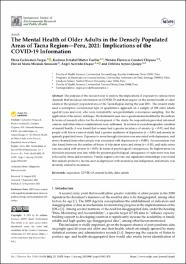Mostrar el registro sencillo del ítem
The Mental Health of Older Adults in the Densely Populated Areas of Tacna Region-Peru, 2021: Implications of the COVID-19 Information
| dc.contributor.author | Cachicatari-Vargas, Elena | es_ES |
| dc.contributor.author | Mutter Cuellar, Karimen Jetzabel | es_ES |
| dc.contributor.author | Condori Chipana, Wender Florencio | es_ES |
| dc.contributor.author | Miranda Socasaire, Flor de Maria | es_ES |
| dc.contributor.author | Acevedo-Duque, Ángel | es_ES |
| dc.date.accessioned | 2022-11-24T21:27:51Z | |
| dc.date.available | 2022-11-24T21:27:51Z | |
| dc.date.issued | 2022-09-12 | |
| dc.identifier.uri | https://hdl.handle.net/20.500.13053/7244 | |
| dc.description.abstract | The purpose of this research was to analyze the implications of exposure to various news channels that broadcast information on COVID-19 and their impact on the mental health of older adults in the sparsely populated area of the Tacna Region during the year 2021. The present study used a descriptive correlational type of quantitative approach on a sample of 389 older adults aged 60 years and over, who were recruited by non-probabilistic convenience sampling. For the application of the survey technique, the instrument used was a questionnaire modified by the authors. In terms of research ethics for the development of the study, the respondents provided informed consent, and other ethical considerations were addressed. In relation to sociodemographic variables of mental health, it was found that women had a greater incidence of anxiety (p < 0.01) and that people with fewer years of study had a greater incidence of depression (p < 0.01) and anxiety in sparsely populated areas. Exposure to news through television was associated with depression, and news obtained from other people was associated with depression (p < 0.001). An association was also found between the number of hours of television news and stress (p < 0.05), and radio news was associated with anxiety (p < 0.05). In terms of psychological consequences, the highest mean for television exposure was fear, while the greatest psychological consequence of radio news was fear, followed by stress and awareness. Finally, negative, inverse, and significant relationships were found that indicate protective factors, such as depression with awareness and indignation, and anxiety was inversely related to awareness. | es_ES |
| dc.format | application/pdf | es_ES |
| dc.language.iso | eng | es_ES |
| dc.publisher | MDPI | es_ES |
| dc.rights | info:eu-repo/semantics/openAccess | es_ES |
| dc.rights.uri | https://creativecommons.org/licenses/by/4.0/ | es_ES |
| dc.subject | COVID-19; exposition; mental health; older adults. | es_ES |
| dc.title | The Mental Health of Older Adults in the Densely Populated Areas of Tacna Region-Peru, 2021: Implications of the COVID-19 Information | es_ES |
| dc.type | info:eu-repo/semantics/article | es_ES |
| dc.identifier.doi | https://doi.org/10.3390/ijerph191811470 | es_ES |
| dc.type.version | info:eu-repo/semantics/publishedVersion | es_ES |
| dc.publisher.country | CH | es_ES |
| dc.subject.ocde | http://purl.org/pe-repo/ocde/ford#3.03.00 | es_ES |
Ficheros en el ítem
Este ítem aparece en la(s) siguiente(s) colección(es)
-
SCOPUS [380]


